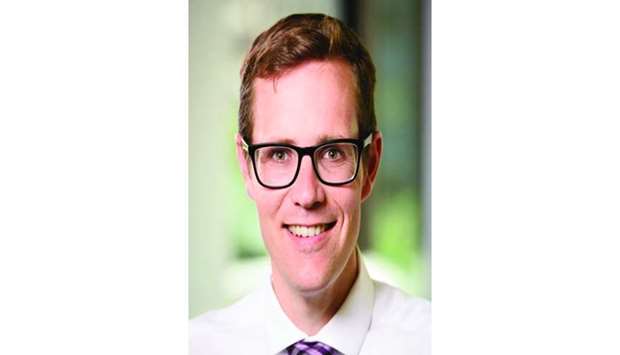US citizens with the least education have been trending towards the Republican Party while many college-educated women shifted towards the Democratic Party over the past 25 years, according to Pew Research Centre research associate Dr Bradly Jones.
“Education is an important dividing line in American politics," he told reporters participating in the first-ever Virtual Reporting Tour (VRT) of the US and the American electoral process.
The US Department of State, in collaboration with Meridian International Centre, organised this eight-week programme for more than 225 journalists (including those from the Middle East) to cover the upcoming US elections remotely.
At the recently-held virtual press briefing, Dr Jones provided an overview of demographics, statistics and trends of the US electorate – factors such as race, ethnicity, gender, generational divides, and regional differences that may shape US Presidential and Congressional Election outcomes in 2020.
Dr Jones said that the Centre, a leading, nonpartisan “fact tank” that informs the public about the issues, attitudes and trends shaping the world, saw that the electorate has been changing in terms of its educational composition over the past 25 years.
In his presentation, he said voters without a college degree have moved toward the Republican Party while those with a college education have trended steadily toward the Democratic Party.
“When we look at both gender and education, we can see that the most dramatic movement has happened among women with a college degree who were about evenly divided in their partisanship in 1994 and now are more than twice as likely to be Democrats as Republicans,” Dr Jones said.
Citing how white voters without a college degree changed their partisanship over the past two years (since 2018) in ‘individual-level data’, he noted that those who began as Republicans were much more likely to stick with the Republican Party compared to White voters without a college degree that were Democrats who would stick with the Democratic Party.
“We see the opposite pattern when we look at White voters with a college degree and non-White voters,” Dr Jones pointed out.
“There's been (movement) for sure, among college-educated men who have gone from 38% identifying or leaning towards the Democratic Party in 1994 to 48% today. But the movement among college-educated women has been much more pronounced and you can see those without a college degree, men have dipped down in their support and then increased in the last 10 years or so moving towards the Republican Party,” he said.
The Centre, which conducts public opinion polling, demographic research, media content analysis, and other empirical social science research, also cited race as one of the most important factors in American politics.
"When we look at voters by race and ethnicity, one of the things that jump out is the relative stability (except perhaps among Asians). White voters are consistently more likely to identify or lean towards the Republican Party during this period,” Dr Jones said. “Black voters overwhelmingly identify or lean towards the Democratic Party, and Hispanic voters are somewhere in the middle.”
“While the partisan compositions of these groups haven't changed much over the past 25 years, the makeup of the American electorate has been changing. Over the past 25 years, the American electorate has diversified greatly. In 1994, 85% of voters in the US were non-Hispanic Whites, that share shrunk to 69% in 2019,” he added.
The US Department of State, in collaboration with Meridian International Centre, organised this eight-week programme for more than 225 journalists (including those from the Middle East) to cover the upcoming US elections remotely.
At the recently-held virtual press briefing, Dr Jones provided an overview of demographics, statistics and trends of the US electorate – factors such as race, ethnicity, gender, generational divides, and regional differences that may shape US Presidential and Congressional Election outcomes in 2020.
Dr Jones said that the Centre, a leading, nonpartisan “fact tank” that informs the public about the issues, attitudes and trends shaping the world, saw that the electorate has been changing in terms of its educational composition over the past 25 years.
In his presentation, he said voters without a college degree have moved toward the Republican Party while those with a college education have trended steadily toward the Democratic Party.
“When we look at both gender and education, we can see that the most dramatic movement has happened among women with a college degree who were about evenly divided in their partisanship in 1994 and now are more than twice as likely to be Democrats as Republicans,” Dr Jones said.
Citing how white voters without a college degree changed their partisanship over the past two years (since 2018) in ‘individual-level data’, he noted that those who began as Republicans were much more likely to stick with the Republican Party compared to White voters without a college degree that were Democrats who would stick with the Democratic Party.
“We see the opposite pattern when we look at White voters with a college degree and non-White voters,” Dr Jones pointed out.
“There's been (movement) for sure, among college-educated men who have gone from 38% identifying or leaning towards the Democratic Party in 1994 to 48% today. But the movement among college-educated women has been much more pronounced and you can see those without a college degree, men have dipped down in their support and then increased in the last 10 years or so moving towards the Republican Party,” he said.
The Centre, which conducts public opinion polling, demographic research, media content analysis, and other empirical social science research, also cited race as one of the most important factors in American politics.
"When we look at voters by race and ethnicity, one of the things that jump out is the relative stability (except perhaps among Asians). White voters are consistently more likely to identify or lean towards the Republican Party during this period,” Dr Jones said. “Black voters overwhelmingly identify or lean towards the Democratic Party, and Hispanic voters are somewhere in the middle.”
“While the partisan compositions of these groups haven't changed much over the past 25 years, the makeup of the American electorate has been changing. Over the past 25 years, the American electorate has diversified greatly. In 1994, 85% of voters in the US were non-Hispanic Whites, that share shrunk to 69% in 2019,” he added.


